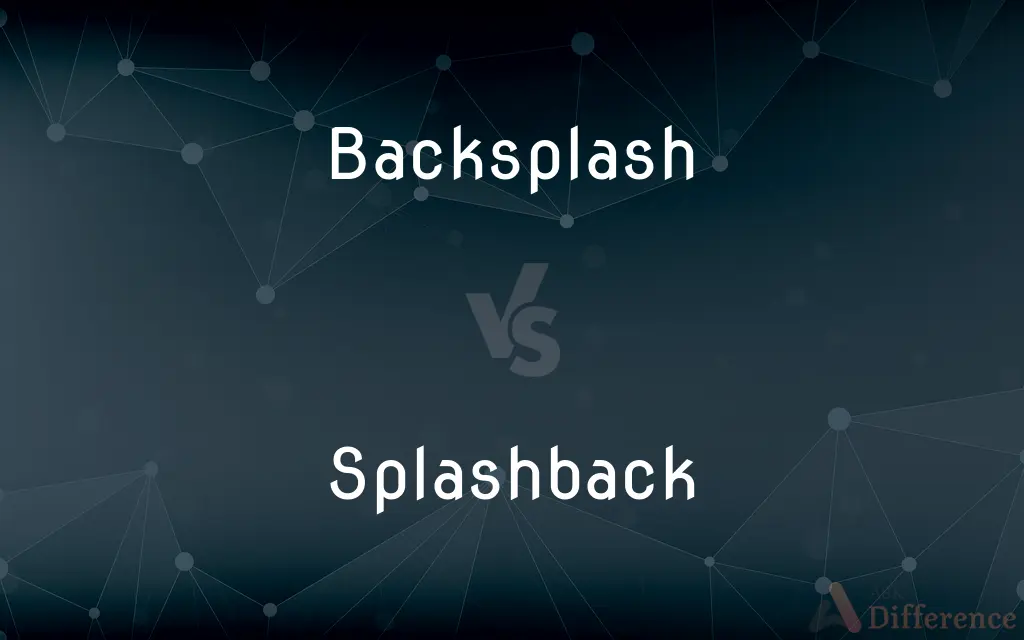Backsplash vs. Splashback — What's the Difference?
Edited by Tayyaba Rehman — By Urooj Arif — Updated on March 27, 2024
Backsplash is a protective panel behind a kitchen counter, while Splashback refers to the same, primarily in British English.

Difference Between Backsplash and Splashback
Table of Contents
ADVERTISEMENT
Key Differences
Backsplash is a term predominantly used in American English to describe a protective surface installed on the wall behind a kitchen sink, stove, or countertop to protect the wall from splashes and stains. On the other hand, Splashback is the British English term for a similar protective panel that serves the same function in kitchens and bathrooms, shielding the walls from water, grease, and other potential stains.
The primary purpose of a backsplash is not only to protect the wall surface from moisture, grease, and food splatters but also to add to the aesthetic appeal of the kitchen. Similarly, a splashback is designed to serve a protective role while often being a focal point in kitchen design, available in various materials like glass, tiles, stainless steel, and more.
Backsplashes can range in height, from a short area just covering the immediate space behind a stove or sink, to a larger area reaching the cabinets above. Splashbacks in the UK might also vary in size, but the term is used interchangeably for both small and large protective panels, regardless of their height or the area they cover.
In terms of installation and materials, backsplashes in the U.S. might incorporate tiles, glass, stone, or stainless steel to match or complement the kitchen's design theme. Splashbacks in the UK and other Commonwealth countries also embrace a wide range of materials, with glass splashbacks being particularly popular for their sleek look and ease of cleaning.
Though the terms backsplash and splashback refer to essentially the same kitchen feature, the choice of term can reflect the speaker's geographic location or familiarity with either American or British English. Both are vital components of modern kitchen design, blending functionality with aesthetic enhancement.
ADVERTISEMENT
Comparison Chart
Term Usage
American English
British English
Location
Behind kitchen counters, stoves
Behind kitchen and bathroom sinks
Function
Protects walls from splashes and stains
Same as backsplash
Materials
Tiles, glass, stone, stainless steel
Glass, tiles, stainless steel, and more
Design Impact
Adds aesthetic appeal to kitchens
Often a focal point in kitchen design
Compare with Definitions
Backsplash
Often made of tiles, glass, or stone to complement the kitchen décor.
Their choice of a glass backsplash brightened the entire kitchen.
Splashback
Utilizes various materials, with glass being a popular choice for its sleek look.
The reflective surface of the glass splashback made the room appear larger.
Backsplash
Protects walls from moisture and makes cleaning easier.
Installing a backsplash behind the stove made kitchen cleanup much simpler.
Splashback
Can be a statement piece, featuring bold colors or patterns.
Their splashback’s vibrant color became the kitchen's focal point.
Backsplash
A protective panel behind counters to guard against splashes, commonly in American English.
The kitchen's backsplash featured hand-painted tiles, adding a unique charm.
Splashback
The British term for a protective wall panel in kitchens and bathrooms.
The glass splashback behind the sink was both practical and stylish.
Backsplash
Adds to the resale value of a home by enhancing kitchen aesthetics.
The designer backsplash was a key feature that attracted buyers to the house.
Splashback
Enhances kitchen design and functionality.
Their choice of a textured splashback added depth to the kitchen's design.
Backsplash
Can extend from countertop to cabinets for added protection and style.
The marble backsplash seamlessly matched the countertops for a luxurious finish.
Splashback
Aims to prevent water damage and ease cleaning efforts.
The splashback’s smooth surface allowed for quick wiping away of splashes.
Backsplash
An upright surface or border, as of tile, that protects the wall behind a sink or stove.
Splashback
Splashes of liquid, especially noxious liquid, rebounding from a surface.
Backsplash
A vertical covering on a wall rising above a countertop or other work surface to protect the wall from spills and to decorate the wall.
Splashback
(countable) A shield of an easily-cleaned material, such as those placed behind an oven top or kitchen sink and at industrial facilities, construction sites, etc, in order to catch splashes of liquid.
The oven comes complete with a stainless steel splashback.
Backsplash
(rowing) The small splash of water that occurs when an oar enters the water to begin a stroke, just before the rower reaches the catch.
Backsplash
(ambitransitive) To splash backward.
Common Curiosities
How does a splashback differ from a backsplash?
Splashback is primarily the British English term for a backsplash, serving the same purpose.
Can backsplashes be made of materials other than tiles?
Yes, backsplashes can also be made from glass, stone, or stainless steel, among other materials.
What is a backsplash?
A backsplash is a protective panel installed behind kitchen counters to prevent wall damage from splashes.
Are backsplashes necessary in a kitchen?
While not strictly necessary, backsplashes are highly recommended for wall protection and aesthetic reasons.
Do splashbacks only protect against water splashes?
Splashbacks protect against a variety of kitchen splashes, including grease and food.
Can splashbacks be installed in bathrooms?
Yes, splashbacks can also be used in bathrooms to protect walls around sinks and bathtubs.
How do I clean a glass splashback?
Use a soft cloth and a non-abrasive cleaner to avoid scratching the glass surface.
Why are glass splashbacks popular?
Glass splashbacks are popular for their sleek appearance and ease of cleaning.
How do I choose a backsplash material?
Choose a material that complements your kitchen’s style and your maintenance preferences.
Do backsplashes add value to a home?
Yes, an attractive and well-installed backsplash can increase a home’s resale value.
How are splashbacks installed?
Splashbacks are typically adhered to the wall with strong adhesives or mounted with screws, depending on the material.
Can splashbacks be customized?
Yes, both backsplashes and splashbacks can be customized in size, material, and design to fit specific kitchen styles.
Can a DIY enthusiast install a backsplash?
Yes, with the right tools and instructions, a DIY enthusiast can install a tile backsplash.
Is it expensive to install a backsplash or splashback?
The cost varies widely depending on the material and the area covered, but investing in quality materials and installation can be cost-effective in the long run.
What’s the trend in backsplash designs?
Trends include using large tiles, continuous materials like glass for a sleek look, and bold colors or patterns.
Share Your Discovery

Previous Comparison
Gaw vs. Gah
Next Comparison
Hotel vs. InnAuthor Spotlight
Written by
Urooj ArifUrooj is a skilled content writer at Ask Difference, known for her exceptional ability to simplify complex topics into engaging and informative content. With a passion for research and a flair for clear, concise writing, she consistently delivers articles that resonate with our diverse audience.
Edited by
Tayyaba RehmanTayyaba Rehman is a distinguished writer, currently serving as a primary contributor to askdifference.com. As a researcher in semantics and etymology, Tayyaba's passion for the complexity of languages and their distinctions has found a perfect home on the platform. Tayyaba delves into the intricacies of language, distinguishing between commonly confused words and phrases, thereby providing clarity for readers worldwide.














































